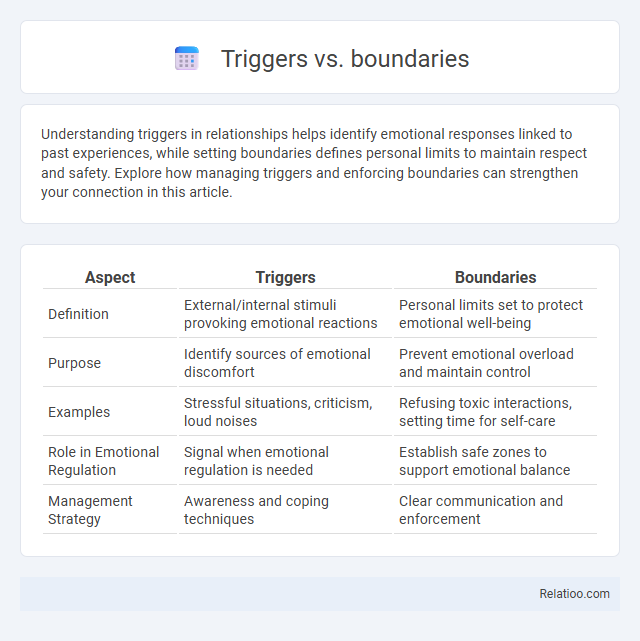Understanding triggers in relationships helps identify emotional responses linked to past experiences, while setting boundaries defines personal limits to maintain respect and safety. Explore how managing triggers and enforcing boundaries can strengthen your connection in this article.
Table of Comparison
| Aspect | Triggers | Boundaries |
|---|---|---|
| Definition | External/internal stimuli provoking emotional reactions | Personal limits set to protect emotional well-being |
| Purpose | Identify sources of emotional discomfort | Prevent emotional overload and maintain control |
| Examples | Stressful situations, criticism, loud noises | Refusing toxic interactions, setting time for self-care |
| Role in Emotional Regulation | Signal when emotional regulation is needed | Establish safe zones to support emotional balance |
| Management Strategy | Awareness and coping techniques | Clear communication and enforcement |
Understanding Triggers: What They Are
Triggers are specific stimuli or events that provoke intense emotional reactions, often linked to past experiences or trauma. They differ from boundaries, which are personal limits you set to protect your emotional well-being and maintain healthy interactions. Understanding triggers helps you identify what causes distress, enabling better emotional regulation and more effective boundary-setting.
Defining Boundaries: Key Concepts
Defining boundaries involves setting clear limits on acceptable behaviors to protect your emotional and physical well-being, distinct from recognizing triggers that provoke intense emotional reactions. Boundaries serve as proactive guidelines for how you expect to be treated, while triggers are often reactive, tied to past experiences that cause distress. Understanding the difference between triggers and boundaries empowers you to communicate your needs effectively and maintain healthy relationships.
Triggers vs Boundaries: Core Differences
Triggers are emotional or psychological reactions sparked by specific stimuli, often tied to past trauma or sensitive experiences, while boundaries serve as personal limits that define acceptable behavior and protect your emotional well-being. Unlike triggers, which are involuntary responses, boundaries are consciously set rules that help regulate interactions and maintain respect in relationships. Understanding these core differences empowers you to recognize when to address internal reactions versus establishing external limits for healthier communication.
The Psychology Behind Triggers
Triggers are emotional responses activated by specific stimuli linked to past experiences, often causing distress; boundaries define personal limits to protect your mental and emotional well-being. The psychology behind triggers involves understanding how the brain associates certain cues with trauma or negative experiences, leading to automatic reactions. Establishing clear boundaries helps manage these triggers by creating a safer environment for your emotional health and promoting resilience.
The Importance of Setting Boundaries
Setting boundaries is essential for maintaining healthy relationships and personal well-being, as it clearly defines acceptable behavior and protects individuals from emotional harm. Unlike triggers, which are specific stimuli that evoke intense emotional responses often rooted in past trauma, boundaries proactively establish limits to prevent undue stress and discomfort. Prioritizing boundary-setting promotes self-respect, reduces conflict, and fosters psychological safety in both personal and professional environments.
How Triggers Influence Emotional Responses
Triggers activate intense emotional responses by recalling past trauma or unresolved feelings, often leading to anxiety, anger, or sadness. Boundaries serve to protect Your emotional well-being by setting clear limits on what is acceptable, preventing unwanted emotional reactions. Understanding how triggers influence Your emotions helps in managing reactions more effectively and maintaining emotional balance.
Recognizing When to Set Boundaries
Recognizing when to set boundaries requires understanding personal triggers that signal emotional discomfort or stress, allowing timely responses to prevent escalation. Boundaries act as protective limits defining acceptable behavior from others, helping maintain mental well-being and healthy relationships. Effective recognition involves identifying specific triggers such as feeling overwhelmed, disrespected, or ignored to establish clear and assertive boundaries that preserve personal integrity.
Strategies for Managing Triggers
Managing triggers effectively requires identifying your personal boundaries and enforcing them consistently to prevent emotional overwhelm. Strategies include mindfulness techniques, grounding exercises, and clear communication of limits with others to protect your mental well-being. Your proactive approach in recognizing and respecting these boundaries helps reduce the intensity and frequency of trigger responses.
Healthy Communication Around Boundaries and Triggers
Understanding the distinction between triggers and boundaries is essential for healthy communication around emotional well-being. Triggers are specific stimuli that provoke intense emotional reactions based on past experiences, while boundaries are personal limits set to protect your emotional and mental space. Clear communication about your boundaries and awareness of others' triggers fosters respect, trust, and empathy in relationships.
Benefits of Balancing Triggers and Boundaries
Balancing triggers and boundaries enhances emotional regulation by allowing individuals to recognize their emotional responses while maintaining healthy limits in relationships. This balance promotes self-awareness and resilience, reducing conflict and stress by preventing overreactions or boundary violations. Establishing clear boundaries alongside understanding personal triggers fosters a supportive environment where emotional well-being and interpersonal respect coexist effectively.

Infographic: Triggers vs boundaries
 relatioo.com
relatioo.com